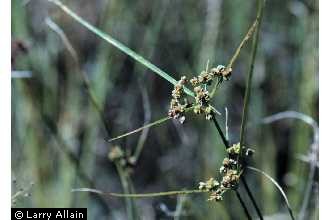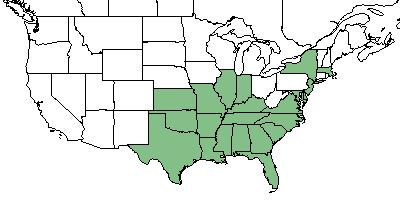Difference between revisions of "Cyperus pseudovegetus"
HaleighJoM (talk | contribs) (→Ecology) |
|||
| (15 intermediate revisions by 4 users not shown) | |||
| Line 1: | Line 1: | ||
{{italic title}} | {{italic title}} | ||
| − | Common Names: Marsh | + | Common Names: Marsh Flatsedge; Green Flatsedge <ref name= "USDA"> [https://plants.usda.gov/core/profile?symbol=CEAM USDA Plant Database]</ref> |
<!-- Get the taxonomy information from the NRCS Plants database --> | <!-- Get the taxonomy information from the NRCS Plants database --> | ||
{{taxobox | {{taxobox | ||
| Line 19: | Line 19: | ||
}} | }} | ||
==Taxonomic Notes== | ==Taxonomic Notes== | ||
| − | Synonyms: ''C. virens'' | + | Synonyms: ''C. virens'' Michaux.<ref name="weakley">Weakley, A.S. 2015. Flora of the southern and mid-atlantic states. Working Draft of 21 May 2015. University of North Carolina at Chapel Hill, Chapel Hill, North Carolina.</ref> |
| − | + | Varieties: none.<ref name="weakley">Weakley, A.S. 2015. Flora of the southern and mid-atlantic states. Working Draft of 21 May 2015. University of North Carolina at Chapel Hill, Chapel Hill, North Carolina.</ref> | |
==Description== | ==Description== | ||
| Line 28: | Line 28: | ||
==Distribution== | ==Distribution== | ||
| − | ''C. pseudovegetus'' is | + | ''C. pseudovegetus'' is native to the eastern United States, including New Jersey and Massachusetts, west to southern Illinois and south Missouri, south to Florida, and west to Texas and Oklahoma.<ref name= "Weakley">Weakley, A. S. (2015). Flora of the Southern and Mid-Atlantic States. Chapel Hill, NC, University of North Carolina Herbarium.</ref> |
==Ecology== | ==Ecology== | ||
| − | ===Habitat=== | + | ===Habitat=== <!--Natural communities, human disturbed habitats, topography, hydrology, soils, light, fire regime requirements for removal of competition, etc.--> |
| − | Common habitats for the ''C. pseudovegetus'' include marshes, ditches, and other depressions with moist soils, for instance samples have been taken from pine flatwoods, edges of ponds and rivers, and other depressions that consist of moist soils. | + | Common habitats for the ''C. pseudovegetus'' include marshes, ditches, and other depressions with moist soils, for instance samples have been taken from pine flatwoods, edges of ponds and rivers, and other depressions that consist of moist soils.<ref name= "Weakley"/><ref name = "FSU herbarium"> URL: http://herbarium.bio.fsu.edu. Last accessed: June 2018. Collectors: Loran C. Anderson, K. Craddock Burks, R. K. Godfrey, R. Kral, P. REdfearn, Sydney Thompson, Culver Gidden, R. Thorne, R. Davidson, R. Norris, Cecil Slaughter, William Platt, Richar Carter, SHaron Carter, W. George. States and counties: Florida (Wakulla, Liberty, Nassau, Franklin, Washington, Leon, Jefferson, Gulf, Gadsden, Holmes, Calhoun, Taylor) Georgia (Thomas, Upson, McIntosh, Lowndes, Clinch, Berrian)</ref> In this habitat, a study found ''C. pseudovegetus'' to colonize an old-field succession site beginning at 5 years since agricultural abandonment, and persisting through 15 years since abandonment.<ref>Battaglia, L. L., et al. (2002). "Sixteen years of old-field succession and reestablishment of a bottomland hardwood forest in the lower Mississippi alluvial valley." Wetlands 22(1): 1-17.</ref> It is also listed as a facultative wetland species, where it commonly occurs in wetlands, but can occasionally be found in non-wetland habitats.<ref name= "USDA"/> This species commonly prefers wet, open habitats with full sun.<ref name= "lady bird"/> |
| − | + | ||
| − | + | Associated species: ''Taxodium'' sp., ''Quercus'' sp., ''Nyssa'' sp., ''Magnolia'' sp., ''Acer rubrum'', ''Liquidambar styraciflua'', ''Cyperus strigosus'', ''C. surinamensis'', ''Carex'' sp., ''Juncus'' sp., ''Hyptis alata'', ''Rudbeckia mohrii'', and ''Eleocharis obtusa''.<ref name= "FSU herbarium"/> | |
| + | |||
| + | ===Phenology=== <!--Timing off flowering, fruiting, seed dispersal, and environmental triggers. Cite PanFlora website if appropriate: http://www.gilnelson.com/PanFlora/ --> | ||
| + | It is known to flower from July to October.<ref name= "Weakley"/> This flowering period is also when fruit is developed.<ref name= "lady bird">[[https://www.wildflower.org/plants/search.php?search_field=&newsearch=true]] Lady Bird Johnson Wildflower Center. Accessed: April 25, 2019</ref> | ||
| + | |||
<!--===Seed dispersal===--> | <!--===Seed dispersal===--> | ||
<!--===Seed bank and germination===--> | <!--===Seed bank and germination===--> | ||
<!--===Fire ecology===--> <!--Fire tolerance, fire dependence, adaptive fire responses--> | <!--===Fire ecology===--> <!--Fire tolerance, fire dependence, adaptive fire responses--> | ||
| − | <!--===Pollination===--> | + | <!--===Pollination===--> |
| − | + | ||
| + | ===Herbivory and toxicology===<!--Herbivory, granivory, insect hosting, etc.--> | ||
| + | ''C. pseudovegetus'' attracts birds, and is highly deer resistant.<ref name= "lady bird"/> | ||
| + | |||
<!--==Diseases and parasites==--> | <!--==Diseases and parasites==--> | ||
| − | ==Conservation and | + | ==Conservation, cultivation, and restoration== |
| − | + | It is listed as rare by the Indiana Department of Natural Resources, and as endangered by the New Jersey Department of Environmental Protection and Energy.<ref name= "USDA">USDA, NRCS. (2016). The PLANTS Database (http://plants.usda.gov, 25 April 2019). National Plant Data Team, Greensboro, NC 27401-4901 USA.</ref> | |
| − | == | + | ==Cultural use== |
==Photo Gallery== | ==Photo Gallery== | ||
<gallery widths=180px> | <gallery widths=180px> | ||
</gallery> | </gallery> | ||
==References and notes== | ==References and notes== | ||
Latest revision as of 09:45, 22 June 2022
Common Names: Marsh Flatsedge; Green Flatsedge [1]
| Cyperus pseudovegetus | |
|---|---|

| |
| Photo from USDA NRCS Plants Database. | |
| Scientific classification | |
| Kingdom: | Plantae |
| Division: | Magnoliophyta - Flowering plants |
| Class: | Liliopsida - Moncots |
| Order: | Cyperales |
| Family: | Cyperaceae |
| Genus: | Cyperus |
| Species: | C. pseudovegetus |
| Binomial name | |
| Cyperus pseudovegetus Steud. | |

| |
| Natural range of Cyperus pseudovegetus from USDA NRCS Plants Database. | |
Contents
Taxonomic Notes
Synonyms: C. virens Michaux.[2]
Varieties: none.[2]
Description
C. pseudovegetus is a perennial praminoid of the Cyperaceae family native to North America. [1]
Distribution
C. pseudovegetus is native to the eastern United States, including New Jersey and Massachusetts, west to southern Illinois and south Missouri, south to Florida, and west to Texas and Oklahoma.[3]
Ecology
Habitat
Common habitats for the C. pseudovegetus include marshes, ditches, and other depressions with moist soils, for instance samples have been taken from pine flatwoods, edges of ponds and rivers, and other depressions that consist of moist soils.[3][4] In this habitat, a study found C. pseudovegetus to colonize an old-field succession site beginning at 5 years since agricultural abandonment, and persisting through 15 years since abandonment.[5] It is also listed as a facultative wetland species, where it commonly occurs in wetlands, but can occasionally be found in non-wetland habitats.[1] This species commonly prefers wet, open habitats with full sun.[6]
Associated species: Taxodium sp., Quercus sp., Nyssa sp., Magnolia sp., Acer rubrum, Liquidambar styraciflua, Cyperus strigosus, C. surinamensis, Carex sp., Juncus sp., Hyptis alata, Rudbeckia mohrii, and Eleocharis obtusa.[4]
Phenology
It is known to flower from July to October.[3] This flowering period is also when fruit is developed.[6]
Herbivory and toxicology
C. pseudovegetus attracts birds, and is highly deer resistant.[6]
Conservation, cultivation, and restoration
It is listed as rare by the Indiana Department of Natural Resources, and as endangered by the New Jersey Department of Environmental Protection and Energy.[1]
Cultural use
Photo Gallery
References and notes
- ↑ 1.0 1.1 1.2 1.3 USDA Plant Database Cite error: Invalid
<ref>tag; name "USDA" defined multiple times with different content - ↑ 2.0 2.1 Weakley, A.S. 2015. Flora of the southern and mid-atlantic states. Working Draft of 21 May 2015. University of North Carolina at Chapel Hill, Chapel Hill, North Carolina.
- ↑ 3.0 3.1 3.2 Weakley, A. S. (2015). Flora of the Southern and Mid-Atlantic States. Chapel Hill, NC, University of North Carolina Herbarium.
- ↑ 4.0 4.1 URL: http://herbarium.bio.fsu.edu. Last accessed: June 2018. Collectors: Loran C. Anderson, K. Craddock Burks, R. K. Godfrey, R. Kral, P. REdfearn, Sydney Thompson, Culver Gidden, R. Thorne, R. Davidson, R. Norris, Cecil Slaughter, William Platt, Richar Carter, SHaron Carter, W. George. States and counties: Florida (Wakulla, Liberty, Nassau, Franklin, Washington, Leon, Jefferson, Gulf, Gadsden, Holmes, Calhoun, Taylor) Georgia (Thomas, Upson, McIntosh, Lowndes, Clinch, Berrian)
- ↑ Battaglia, L. L., et al. (2002). "Sixteen years of old-field succession and reestablishment of a bottomland hardwood forest in the lower Mississippi alluvial valley." Wetlands 22(1): 1-17.
- ↑ 6.0 6.1 6.2 [[1]] Lady Bird Johnson Wildflower Center. Accessed: April 25, 2019